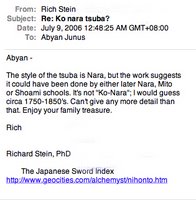 (Please See post below this one for the email I wrote to Proffessor Stein. Yey. Nara here I come. At least I know that the tsuba was made around the time my great grandfather was born. For those interested, below is a write up on Nara Tsubas. I have also found out where the Japan Center for Asian Historical Records is - They keep records from Meiji Era- WWII: 1870-1949.)
(Please See post below this one for the email I wrote to Proffessor Stein. Yey. Nara here I come. At least I know that the tsuba was made around the time my great grandfather was born. For those interested, below is a write up on Nara Tsubas. I have also found out where the Japan Center for Asian Historical Records is - They keep records from Meiji Era- WWII: 1870-1949.)Ko-Nara tsuba, also called old Nara or early Nara tsuba, were a style of decorated iron plate tsuba popular from the Momoyama period through the mid Edo period. This group produced tsuba with kinko (soft metal) Goto style inlay on iron plates, some of which may have been produced by other tsukako - possibly Saotome makers. The first Nara master, Toshiteru, is believed to have studied under the Goto school and applied the Goto kinko techniques to iron plate tsuba. The Ko-Nara group are those makers working before approximately 1700 who preceeded the fourth Nara Master, Toshinaga. While this type of tsuba is called Ko-Nara, they were made by a variety of different makers, some only distantly related to the Nara school. The later or new Nara school (Shin Nara) became one of the most prolific and influential schools of tsuba and kodogu makers producing works into the Meiji Period. It is the later Nara work that most collectors refer to as the Nara school. The Three Great Nara Masters (Nara Sansaku) were Toshinaga (aka Riju) (1667-1737), Sugiura Joi (1700-1761) and Tsuchiya Yasuchika (1669-1744). Works by the great Nara masters are often reproduced, copied or forged (gimei).
The Ko-Nara and Nara school are considered by some to be the progenitors of many other schools of tsubako, the Hamano, Shonai Shoami and Iwamoto schools among others. It was artisans of the Nara school who formed the Hamano school. The style of the Nara school was often copied by workers of the Aizu Shoami and Mito schools of tsuba and kodogu makers. The work of Hamano, Aizu Shoami and Mito are often difficult to distinquish from that of the Nara makers. It is not unusual to see tsuba in this genre all labeled as Ko-Nara style.
CHARACTERISTICS OF KO-NARA TSUBA
These tsuba are characterized by well forged and hammered iron plates decorated with figural and naturalistic motifs in gold, silver, shaduko and copper inlay. The motifs commonly depict stories from Japanese or Chinese mythology or various naturalistic themes. On the better tsuba, the decor is quite detailed and extremely well done, rivaling that found on Goto or Soten tsuba in my opinion. Most Ko-Nara tsuba are done in maru-gata or mokko-gata. Iron bones (tekkotsu) are commonly seen on the edge (mimi) of Ko-Nara tsuba which are sukidashi or uchikaeshi. The surface is normally tsuchime (hammered finish) although some smooth plates were done and the carving done in shishiai (sunken relief) style; some will have iron on iron inlay which appears takabori (high relief carving). Ko-Nara tsuba are rarely signed.
No comments:
Post a Comment